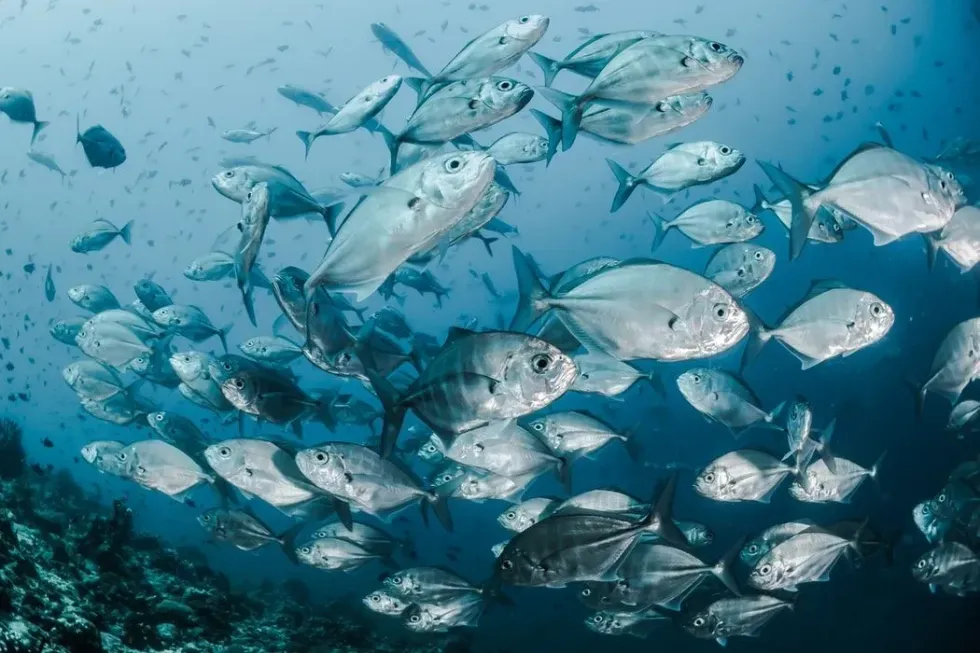The bigeye tuna is a very common fish, and it is extremely interesting to learn about them. There are various types of these fish depending on their habitats, such as the Atlantic bigeye, the Pacific bigeye, and more.
They can be found on the east, south, and west coast, of the Pacific, along with the Indian Ocean, and in the cooler waters of the Atlantic oceans.
All of them are highly migratory species. With regards to their looks, their upper sides are a dark metallic blue, and their fins are bright yellow.
Their lower sides and belly are white in color. However, these beautiful fishes are being caught in tuna fishery And then transported through purse seine vessels of the South Pacific.
For this reason, conservation measures are being taken for these fishes.
Read on to know more about the bigeye tuna price, bigeye tuna recipe for cooking, bigeye tuna fishing, bigeye ahi tuna, the difference between bluefin and bigeye tuna, juvenile bigeye tuna, bigeye tuna tail, bigeye tuna size, bigeye tuna population size, and more. You will also find out more about how temperate waters are most suitable for them.
For more similar content, check out barracuda and yellowfin tuna.
Bigeye Tuna Interesting Facts
What type of animal is a bigeye tuna?
The bigeye tuna is a type of fish.
What class of animal does a bigeye tuna belong to?
The bigeye tuna (Thunnus obesus) belongs to the class Actinopterygii.
How many bigeye tuna are there in the world?
The exact population of the bigeye tuna (Thunnus obesus) remains unknown for the current year. However, in 2013, the strength of the total catch was estimated at around three million metric tons. The recent number of this specie of tuna fish has declined due to excessive fishing practices.
Where does a bigeye tuna live?
The bigeye tuna species can be seen living in oceans. They reside mainly in temperate and tropical waters. These species are a resident of the eastern Pacific Ocean as well as western and the central Pacific Ocean.
This gives it the name Pacific bigeye. Apart from the eastern Pacific, or the western and central Pacific, they can also be found in the Indian Ocean and the Atlantic Ocean. In spite of their abundance in temperate and tropical waters, this species is not found in the Mediterranean Sea.
What is a bigeye tuna's habitat?
By nature, the bigeye tuna fish is epipelagic. It means that they prefer to reside near the sea surface.
It is so because this region receives enough sunlight for algae to grow, which consequently draws more small fish, which further act as prey for the bigeye tuna. Wandering around the surface can be seen mostly at night because it is after nightfall that there is an increased crowd of fishes near this area.
During the day, in contrast, the bigeye tuna dives as deep as 1500 ft (457 m).
Who does bigeye tuna live with?
This species of tuna are known to form big groups with other bigeye tunas, which are called a school. They do not only form schools within their own species but also with other species of tuna or even other fishes. This helps them as they are a highly migratory species.
How long does a bigeye tuna live?
The average lifespan of a bigeye tuna fish is about nine years. On some occasions, they can also live up to a period of 15 years.
How do they reproduce?
Although in places that fall under higher latitudes (like the western Pacific or eastern Pacific), the bigeye tuna mates more seasonally, they are generally found reproducing throughout the years in temperate waters or other habitats. Reproduction in this species happens through external fertilization.
This means that the female of this species releases its million eggs into the sea. The bigeye tuna spawn is then subsequently fertilized by the male sperm. Thereafter, millions of eggs are fertilized in the water and turn into larvae.
At this stage, it lives as zooplankton. After some more growth, they develop into juvenile bigeye tuna and further into adult bigeye.
What is their conservation status?
The conservation status of this species of tuna fish is listed as Vulnerable by the International Union for Conservation of Nature (IUCN) Red List.
The vulnerable state of this fish is because of the overfishing of this species. Apart from overfishing with fishing gear, another problem that persists for this fish is changing the marine climate as a result of climate change.
In lieu of depleting the population of this species, the World Wildlife Federation (WWF) is implementing stricter guidelines for fisheries so that there is some measure to restock this species.
Bigeye Tuna Fun Facts
What do bigeye tunas look like?

As the name suggests, the most eye-catching and distinctive feature of these fishes is their big round eyes. They have large heads too. Their pectoral fins are long, and these can reach up to their second dorsal and anal fin in young bigeye tunas. Beneath their second dorsal and anal fin is their spine.
Their dorsal spines are approximately 13-14 in number. Their lower sides and belly are white, which is in contrast to their metallic upper sides. Their finlets are bright yellow and not just pale yellow.
How cute are they?
The bigeye tuna is not cute to look at. They resemble a typical fish and might even be called ugly by some. There is nothing particularly appealing about their features. However, some might find them to be cute.
How do they communicate?
Although there is no specific research or data on the communication modes of the bigeye tuna, in particular, it can be said that they communicate like other species of the tuna. Communication in the tuna takes place through a chemical process.
The tuna species also make use of their sight for communicating. Their lateral lines are quite well developed, which also acts as a system for interaction.
How big is a bigeye tuna?
The bigeye tuna is about 98 in (250 cm) long. It is around 23 times bigger in length than a clownfish.
How fast can a bigeye tuna swim?
The exact swimming speed of the bigeye tuna remains unknown, but the average tuna is known to be a fast swimmer with an approximate speed of 46 mph (74 kph).
How much does a bigeye tuna weigh?
The bigeye tuna weighs approximately 400 lb (180 kg).
What are their male and female names of the species?
There is no separate name for the male and female sexes of this tuna. They are simply called the male and female bigeye tuna.
What would you call a baby bigeye tuna?
The offspring of a bigeye tuna is called a baby bigeye tuna.
What do they eat?
The bigeye tuna is known to include celaphods like octopus, squids, and more in their diet like fish, crustaceans, and more as part of their food chain. They eat crustaceans like shrimps.
However, their main prey is epipelagic fishes, that is, fish that live near the surface of the water. Their diet is not restricted to the upper surface of the water.
They also hunt fishes in the mesopelagic layer, that is, the middle part of the water body. This layer of the water is also known as the twilight zone because of the amount of light that reaches this layer.
Is it edible?
Yes, bigeye tunas are edible. They are readily used as the main ingredient to make sashimi, which is a famous dish in Japanese cuisine. They have a little bit of edible fat in their bodies. Their taste is moderate in nature but stronger than that of yellowfin tuna. These tunas have a meaty texture.
Would they make a good pet?
They can be kept as pets but whether they will make good pets is questionable. It is so because they prey on other small fish.
Hence, it will be a smart move not to mix these tunas with any other fish, especially small fish. However, it might be a really useful idea to keep these tunas as pets as a measure to reduce depletion in their numbers due to fishing.
Did you know...
The bigeye tuna is delicious to eat. Hence the reason they are caught so much in fisheries. However, they have a very high mercury content. As a result, they should always be consumed or cooked in restricted amounts.
Bigeye tuna vs. bluefin tuna
In terms of size, the bluefin tuna is much bigger than the bigeye tuna. Another difference lies in their appearances.
The bluefin tuna does not have round bulging eyes like the bigeye tunas. The fat content in the body of the bluefin is also more than that of the bigeye tunas. Lastly, bluefin tunas are the costliest of the lot.
What is the difference between yellowfin tuna and bigeye tuna?
The yellowfin tuna is the smallest among the species of tuna. Hence it is smaller in size than the bigeye tuna.
A specific feature of the yellowfin tuna is that it has a distinct yellow fin which is missing in the bigeye tuna. When it comes to consumption of these fish, the meat of the yellowfin tuna is less red in color, has less fat, and has smaller grains.
Is bigeye tuna the same as ahi?
Yes, they are one and the same. In Hawaii, the term 'ahi' refers to both the yellowfin tuna and the bigeye tuna. Thus, the bigeye tuna is a part of ahi.
Here at Kidadl, we have carefully created lots of interesting family-friendly animal facts for everyone to discover! Learn more about some other fish including skipjack tuna or albacore.
You can even occupy yourself at home by drawing one of our bigeye tuna coloring pages.










